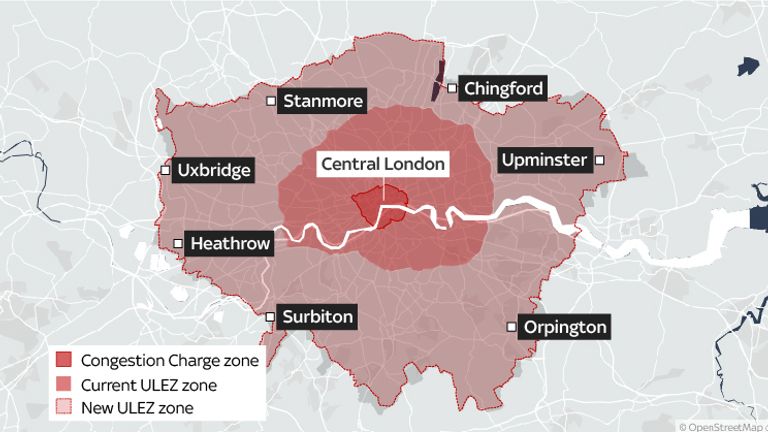 Charges will hit hundreds of thousands more drivers
Charges will hit hundreds of thousands more drivers
Mayor Sadiq Khan says there is “still far too much toxic air pollution” in the capital, “leading to cancer, lung disease, dementia and asthma”.
London’s Ultra Low Emission Zone (ULEZ) is being expanded to cover the entire city, which the mayor says will tackle air pollution and congestion.
Sadiq Khan has announced the change will come into effect on 29 August 2023, and operate across all London boroughs.
The zone will be 18 times larger than its current area – the boundary is currently the North and South Circular roads.
Transport for London (TfL) estimates that on a typical day about 160,000 cars and 42,000 vans will be liable for the daily fee of £12.50.
But transport officials believe the expansion of the scheme, initially proposed back in May, will encourage motorists to change to vehicles with lower emissions, or switch to public transport.
London’s mayor Sadiq Khan said: “Londoners are developing life-changing illnesses, such as cancer, lung disease, dementia and asthma,” adding that pollution leads to “kids in our city growing up with stunted lungs”.
“There is still far too much toxic air pollution permanently damaging the health of young Londoners and leading to thousands of early deaths every year”.
He described the introduction of ULEZ as being “transformational”, reducing harmful pollution levels by almost a half in central London.
Who pays the Ultra Low Emission Zone (ULEZ) charge?
Owners of the most polluting cars and vans have to pay a daily fee of £12.50 when in the zone.
Most diesel vehicles registered from 2016 and petrol models registered from 2006 are exempt.
There is a different charge called the Low Emission Zone (LEZ) starting from £100 a day for heavier vehicles which don’t meet certain emissions standards.
A separate Congestion Charge costs £15 a day and covers central London.
How will Londoners benefit?
TfL said the zone will cover an extra five million people, taking in the outer London boroughs which suffer the greatest number of deaths from pollution.
Transport officials predict the policy will mean that outer London will experience a reduction in 27,000 tonnes of CO2; a fall in nitrogen oxides (NOx) from cars and vans by 10% and 7% respectively; and a cut in PM2.5 car exhaust emissions (tiny particles of soot) by nearly 16%.
What else has been announced?
There will also be a £110m scheme to encourage those on certain benefits, charities and disabled people, to apply for grants of up to £2,000 to scrap non-compliant cars or motorcycles.
A grace period for the new ULEZ charges will also cover more than 280,000 disabled people.
What has the reaction been?
Environmental groups are delighted, but the RAC has described it as “a hammer-blow for desperate drivers and businesses already struggling with crippling fuel costs”.
And the Federation of Small Businesses said the ULEZ expansion will “leave many small firms in a precarious position”.








